Ecosystems and Community Change
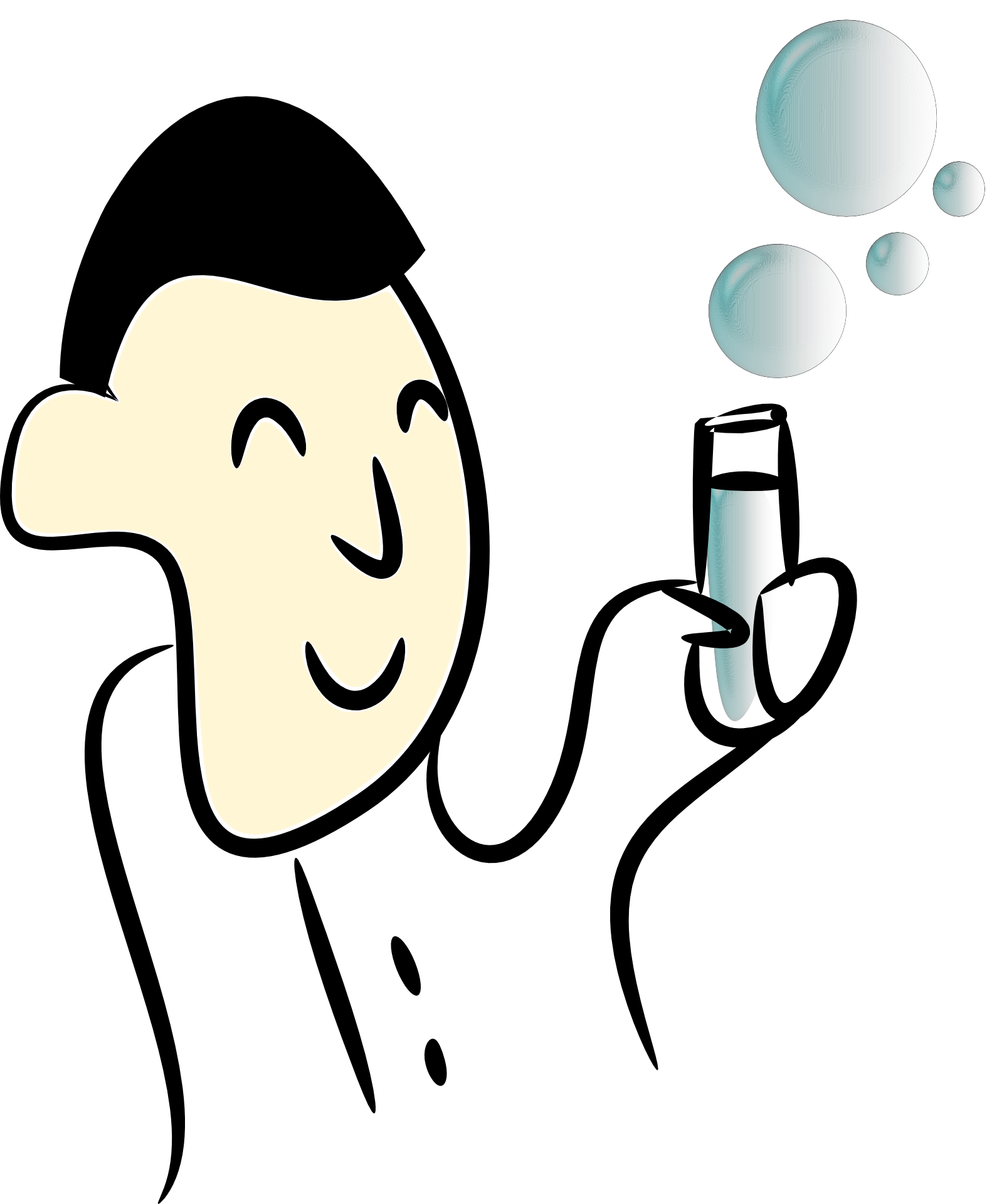

We have previously defined an Ecosystem as consisting of several communities (living organisms/ biotic component) and the non-living (abiotic) components such as rainfall and temperature. Because these components are dwelling in the same environment, they will interact in various ways to be successful in surviving and reproducing in the environment.
Ecosystems do not have sharp boundaries, organisms can move between ecosystems. Ecosystems also do not change abruptly; there is usually a transition area which has characteristics of both ecosystems. These transition areas are called Ecotones. As expected, ecotones contain species from all bordering ecosystems, so they are expected to contain greater biodiversity than the ecosystems.
Ecosystems with greater biodiversity tend to be less fragile. For example if a predator has to rely on a single species as a food source, its very existence is tied to the survival of the prey. In ecotones and other diverse areas, there are more species, and a predator may have an alternative prey if something happens to the population of its main prey.
A Niche is the organism's role in an ecosystem, consisting of its habitat, its place in the food web, breeding area and time of day at which it is more or less active. An organism's niche helps to reduce competition for limited resources such as food. For example, Owls hunt down prey with in forests, Hawks hunt for prey in grassland. Owls are nocturnal, Hawks hunt during the day.
A Fundamental niche is the set of resources a population is capable of using under ideal conditions. While, a Realized niche defines the resources a population actually uses.
When a new species enter an ecosystem, it causes a disturbance because it comes into competition for a niche with one or more of the already existing species. Species that are native to an ecosystem are called Exotic Species. Consequences of introducing Exotic Species:
Biomes
Biome is a large geographical region with a specific climate, and the plants and animals that are adapted to that climate.. Examples of Biomes include Tundra, Taiga, Temperate deciduous forest, Grassland.
Examples of Ecosystems include Taiga, Muskeg, Grassland and Deciduous Forest.
1. Soil.
Soil is made up of a series of layers -
The soil characteristics, such as the quality and quantity of the layers will influence productivity and thereby influence the vegetation and all the living organisms in the food chain. Other soil characteristics that influence the ecosystem include soil pH, mineral content etc.
2. Water
Water is a fundamental need for all living organisms. The impact of water in the ecosystem depend on how much precipitation occurred, how long the moisture stays on the soil and how much is collected beneath the soil. These factors influence how much water is available to be used by plants and animals thereby influencing the composition of these living organisms in the ecosystem.
3. Temperature
Most organisms are adapted to live within specific temperatures. For example, some trees keep their leaves during winter but grow slowly during summer. By doing this, they conserve energy that would have been needed to develop new leaves every growing season. Other trees shed their leaves during winter and grow fresh leaves during the growing season. Some animals are able to survive within certain temperatures by altering their behavior and physiological functions through processes like hibernation, migration etc.
4. Sunlight
Depending on the position of the ecosystem in relation to the equator, some parts of the earth will receive different amount of sunlight both in terms of intensity and duration. Areas close to the equator receive almost 12 hours or sunlight and 12 hours of darkness every day. This has influenced the type of vegetation that dominates these regions. While areas on the north, such as Canada, receive less sunlight during winter with short days, but receive a lot more sunlight during summer with days, in some areas, longer than 18 hours. The day length influences plant growth rate.
1. Freshwater vs saltwater.
The amount of dissolved substances in the water, including minerals, nitrogen, pollutants. The affect the amount of dissolved oxygen, which also depends on temperature, pressure (depth of water), and amount of salt & other dissolved substances.
2. Temperature and Oxygen.
The depth of water as well as seasons affects both temperature and Oxygen. In winter Ice/snow (less dense than water) covers the surface of lakes and provides insulation. As a result, the water underneath the ice remains warmer and the temperature does not fluctuate. However, because of the sheet of ice on the surface of water, there is relatively less oxygen that reaches the water underneath the ice. In spring, as ice melts, there is increased Oxygen from the air getting into the water. In summer, the upper level of the lake (called epilimnion) warms up faster, while the lower level of lake (called hypolimnion) remains at low temperature. The middle level of lake (called thermocline) drops in temperature from warm to cold. In fall, water goes from warm to cool, becoming more dense and sinks to bottom of the lake. This helps to rotate oxygen levels to the bottom of the lake and the water that come to the surface gets oxygen from the atmosphere.
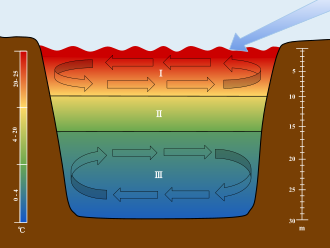
Lakes are stratified into three separate sections- I - The Epilimnion, II - The Metalimnion, III - The Hypolimnion. (Source: Wikipedia, CC BY-SA 3.0)
Biotic Potential
Biotic Potential describes the maximum number of offspring that a species could produce when there are unlimited resources in the environment. Several factors influence biotic potential:
Abiotic Limiting Factors
Several factors in the environment can prevent populations from achieving their biotic potential. Resources that are in short supply, such as, Food Water Territory Presence of pollutants and other toxic chemicals, will limit the specie's biotic potential.
Carrying capacity describes the maximum number of individuals of the same species that can be supported by an ecosystem. Carrying capacity for any species is determined by the supply of resources such as food and water. When populations exceed the carrying capacity, the environment becomes depleted and the resources cannot be replenished. This then results in a decline in the population, with or without a rejuvenation of the environment.
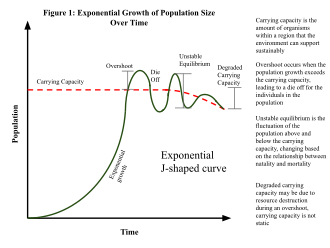
The figure illustrates the carrying capacity of an environment and the fluctuations that occur when the carrying capacity is exceeded. (Source: Wikipedia, CC BY-SA 3.0)
Limits of tolerance describes the range of environmental conditions under which the species can tolerate. The Law of Tolerance states that an organism can survive within a particular range of an abiotic factor. The Law of the minimum states that the nutrient in the least supply is the one that limits growth of the population. So even if the environment has sufficient feed, if there is no sufficient water, the limited supply of water is what will limit the growth of the population.
Density-independent factors includes those factors in an ecosystem that affect members of a population regardless of population density. These tend to be mostly associated with abiotic factors such as drought, fire, floods.
Density-dependent factors - a factor in an ecosystem that affects members of a population because of the population density. Examples include food shortage, diseases, water supply etc.
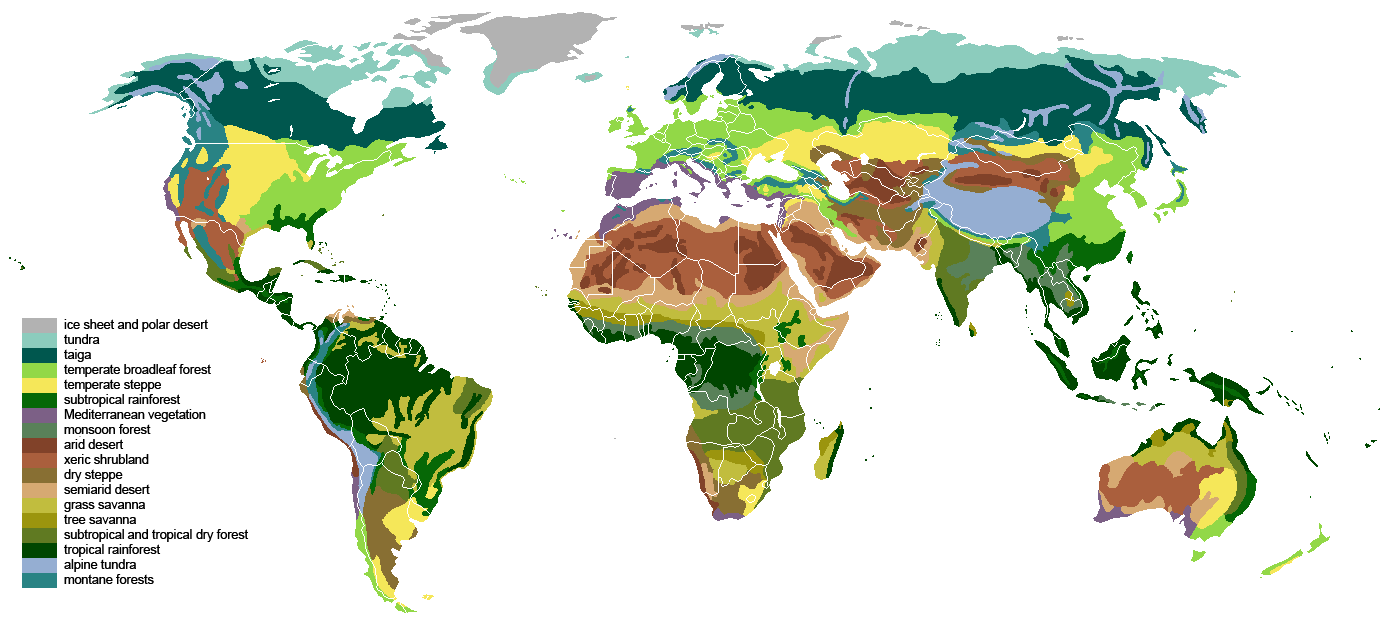
Biomes of the world. (Source: Wikipedia, CC BY-SA 3.0)
Download a pdf copy of Unit 4 - Population Change for offline use.
C$0.99
Taxonomy is the science of classifying organisms according to inferred characteristics and relationships among them
In biology, the binomial nomenclature system is used. This system was developed by Carolus Linnaeus and involves two part Latin scientific name. The first part is the genus (if many- genera) and the second part is the descriptive name or species name. Each genus can include many species of related organisms. For example, Felis sylvestris is the domestic cat, Felis lynx refers to the lynx.
Taxonomy includes seven levels of classification.
Each taxonomic level is more inclusive than the one below, and the more closely related two species are, the more levels they share.
The binomial nomenclature system utilizes the background of the evolution theory, part of which indicates that all organisms originated from the same organisms and evolved into the diversity that we can all observe.
Phylogeny is the study related to the history of the evolution of an organism. As new species form, the branches can be illustrated in a phylogenic tree. Phylogenetic trees start from oldest ancestor and branches off to descendants.
If all organisms (plants, animals and microorganisms) are put into a phylogenetic tree, the result can be described as the 'tree of life'.
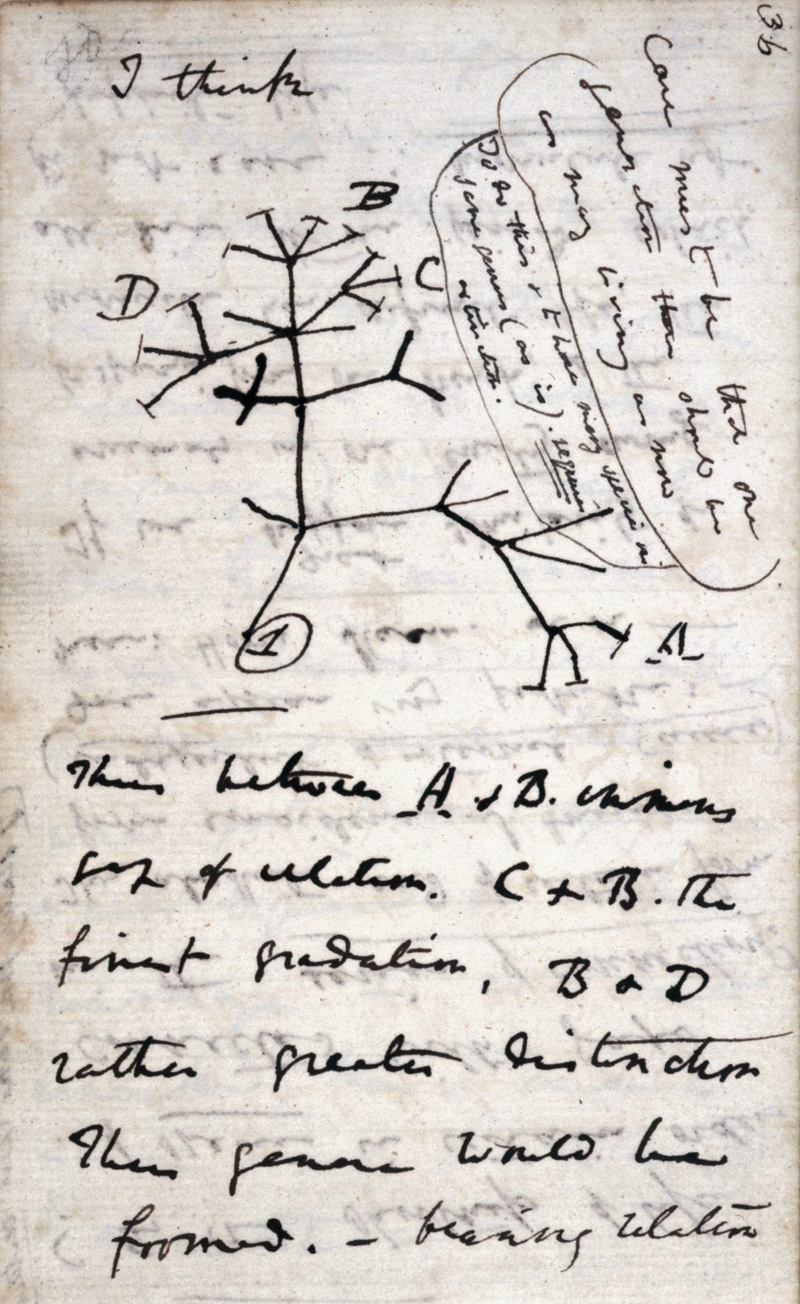
The tree of life as first conceived by Charles Darwin. (Source: Wikipedia, CC BY-SA 3.0)
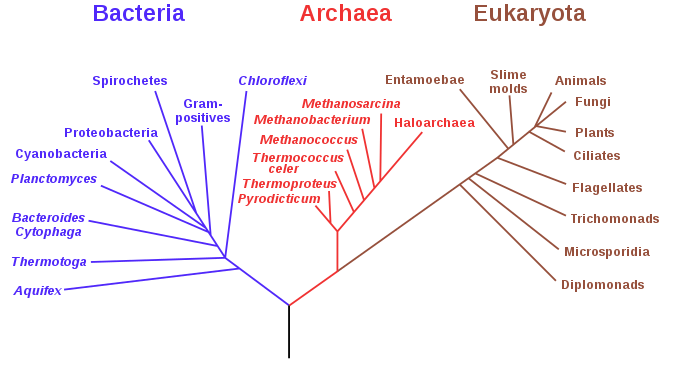
The modern tree of life - painfully summarized. (Source: Wikipedia, CC BY-SA 3.0)
The Dichotomous key is a sequential procedure to classify a group of organisms into groups where the lowest level contains organisms that have the most number of similarities.
Dichotomous Key Steps
1. List the characteristics.
Examine the specimens to identify and list down the characteristics that you can notice. For example, if you are classifying a group of animals, you may identify some that have hair, fur or feathers, and short or long tails, etc.
2. Develop an Order for the characteristics.
Order the characteristics such that the most general characteristics are first, before moving to the more specific characteristics. The general characteristics are the more obvious ones. For example, when it comes to Tail, you can start by indicating whether a sample has a tail or not, followed by classifying the specimens that have a tail, into groups of whether the tail is long or short.
3. Divide the specimens.
Start using the characteristics ordered above to divide the specimens. Statements are used in pairs (Dichotomous) with one statement indicating a Yes and the other contrasting statement indicating a NO. See example of dichotomous key below.
4. Divide the specimen even further.
Proceed with the contrasting statemens, speciments that fully fit the YES statement ONLY are considered classified. The NO statement will usually have a reference to another statement, which further sub-divides the specimens.
5. Draw a dichotomous key.
See example below.
6. Test the key.
Select any specimen (randomly) and go through the dichotomous key you created until you get to the point the specimen is fully classified. Repeat this process for the rest of the specimens. At this point you may find it necessary to rearrange your dichomtomous key questions.
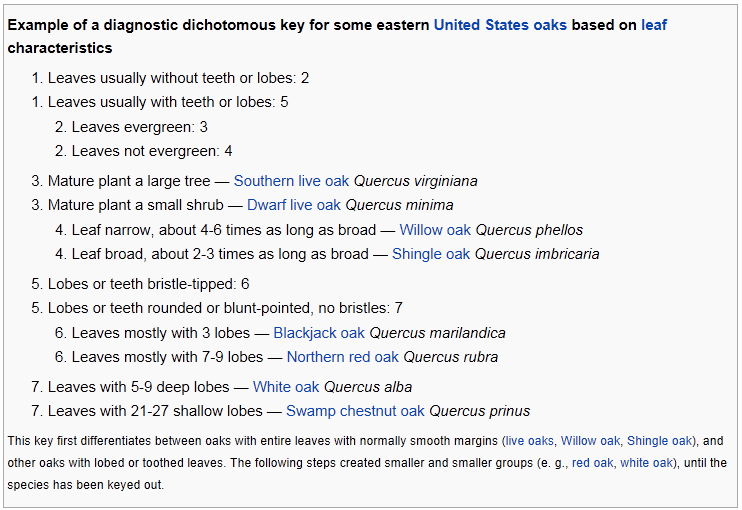
An example of a dichotomous key. (Source: Wikipedia, CC BY-SA 3.0)
Population - A group of individuals of the same species living in the same geographical area at the same time.
Community - A group of individuals of different species /interacting populations in a given geographical area.
Ecosystem - A collection of several communities and with the abiotic factors that surround and affect them.
Biosphere - All of the areas on Earth (atmosphere, lithosphere, and hydrosphere) that are inhabited by and that support life.
Biotic - Refers to living things in the environment, such as humans, trees, fish, or fungi.
Abiotic - Refers to the non-living components of the environment, including sunlight, water, soil, temperature etc.
Ecological Niche - The biological role that a member of a population play in the community, including the resources that member needs and the way in which they interact with other members of the community.
Adaptation - refers to a physical/structural characteristic, behavioral or physiological/functional process that makes an individual more likely to survive and reproduce in an environment.
Evolution is change in the heritable characteristics of biological populations over successive generations. A heritable characteristic is a trait/characteristic/phenotype that can be passed from one generation to the other through DNA. The term 'generation' usually has several definitions but the most common is the amount of time it takes for individual from birth to the time when that individual start getting children of their own. This is usually approximately 30 years.
Genetic variation is formation of individuals differing at the genetic level (genotype), or the presence of genotypically different individuals. This differs from variation, which includes all differences including environmentally induced differences, which, as a rule, cause only temporary, non-heritable changes of the phenotype.
Natural Selection is the differential survival and reproduction of individuals due to differences in specific traits. If a specific trait makes an individual better at surviving and/or reproducing in a certain environment, then the favored characteristics will become more prevalent in the population resulting in a net change between generations. Individuals with traits that result in less survival or reproduction will be slowly eliminated from the population.
The scientific theory of evolution by natural selection was developed independently by Charles Darwin and Alfred Russel Wallace in the mid-19th century then it was published in detail in Darwin's book On the Origin of Species. (1859)
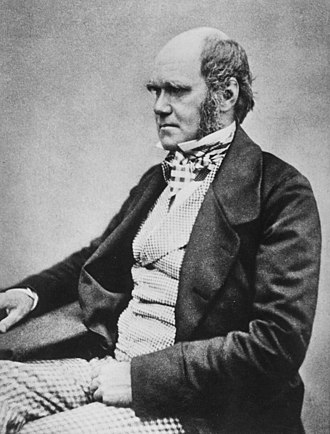

Charles Darwin (left) and Alfred Russel Wallace (right). (Source: Wikipedia, CC BY-SA 3.0, No alterations made)
For natural selection to occur, three properties must be met:
Fitness describes individual reproductive success. It is the individual's average contribution to the gene pool of the next generation that is made by individuals of the specified trait. Because traits are determined by genes, (genotypes), the fitness of a phenotype indicates the fitness conferred by the corresponding genotype. Fitness is correlated to the environment, so a trait may be fit in an environment A, but unfit for environment B. Natural selection can be described as the survival of the fittest, resulting in the preservation of favored races in the struggle for life. This concept can also be referred to as 'Descent with modifications'. Although this phrase is more general, describing the fact that offspring do not always look exactly alike to their parents. If these differences between offspring and parents result in the offspring being better adapted to the environment, then natural selection will occur in their favor.
Direct Evidence
Indirect Evidence
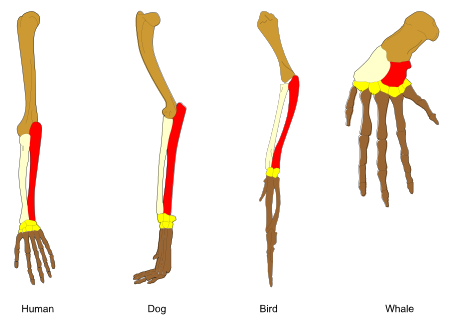
Homologous structures in divergent evolution. (Source: Wikipedia, CC BY-SA 3.0, No alterations made)
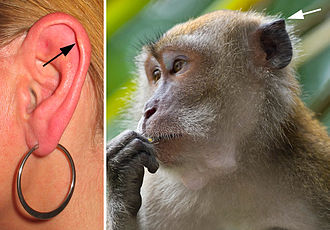
The Darwin tubercle is thought to be a vestigial part of the ear that used to be pointy in the ancestors. (Source: Wikipedia, CC BY-SA 3.0, No alterations made)
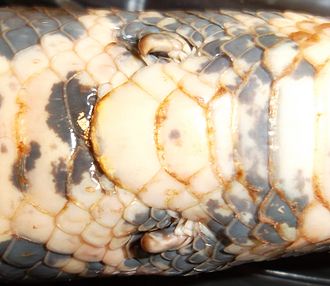
Vestigial hind legs in a snake. (Source: Wikipedia, CC BY-SA 3.0, No alterations made)
Mutations, which are changes in the DNA sequence of an individual. Mutations may alter the function of the gene and resultant proteins.
Sex and recombination: During sex, characteristics and genes from one parent and mixed with genes from the other parent to and create a hybrid. As generations go by, genetic material is mixed and combined in various ways resulting in offspring that are widely different from their parents.
Gene flow: Through processes such as migration. Gene flow introduces genes and traits that did not previously exist in the population.
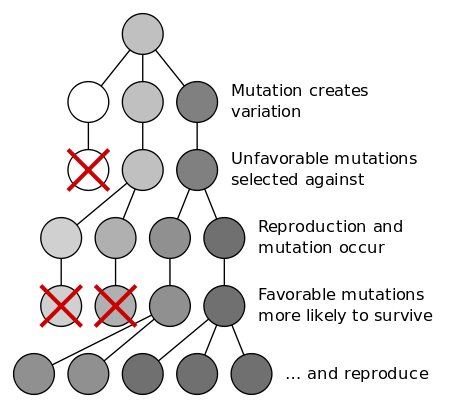
The diagram illustrates the development of a mutation followed by selection against the mutation. (Source: Wikipedia, CC BY-SA 3.0, No alterations made)
The evolution of the peppered moth is a classic example of natural selection. It is an evolutionary example of color change in the moth population as a consequence of air pollution during the Industrial Revolution resulting in the increase in the frequency of dark-colored moths. Later, when pollution was reduced, the light-colored moth became most prevalent.
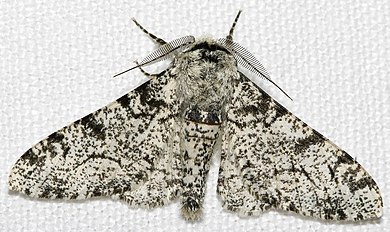
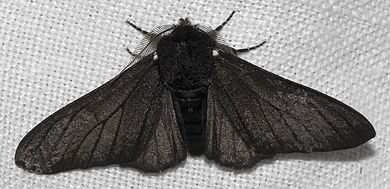
The light coloured vs black/dark coloured moth. (Source: Wikipedia, CC BY-SA 3.0, No alterations made)
Artificial selection is when humans select individuals with the desirable characteristics to use for breeding to produce offspring with even better performance in the desirable characteristics.
Apart from Natural vs Artificial selection, selection can also be categorized according to the outcomes. In this case, there are three types of selection.
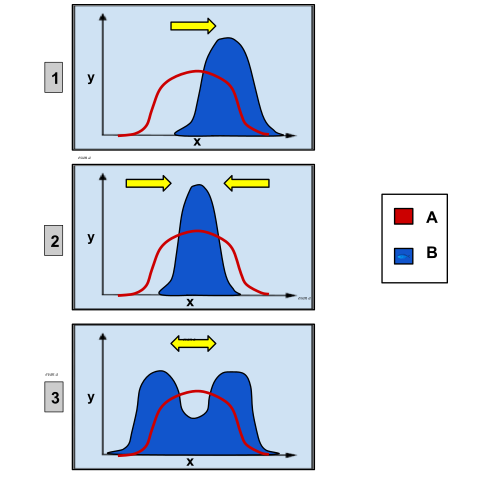
In this figure, A represents the distribution of the trait before selection, while B represents the trait after selection. (Source: Wikipedia, CC BY-SA 3.0, No alterations made)
Lamarck is generally remembered for the theory of inheritance of acquired characteristics, called Lamarckism, soft inheritance, or use/disuse theory. Lamarck hypothesized that organisms change because they need to change. For example, snakes needed to crawl through small space so legs were scrapped off. Organs that are used remains strong while disused organs are weakened and disappears. Lamarckism also added that traits acquired in an individual's life-time could be passed on to offspring. for example, masters of the piano pass on skills to offspring.
You can access Tensai High School Biology revision questions HERE